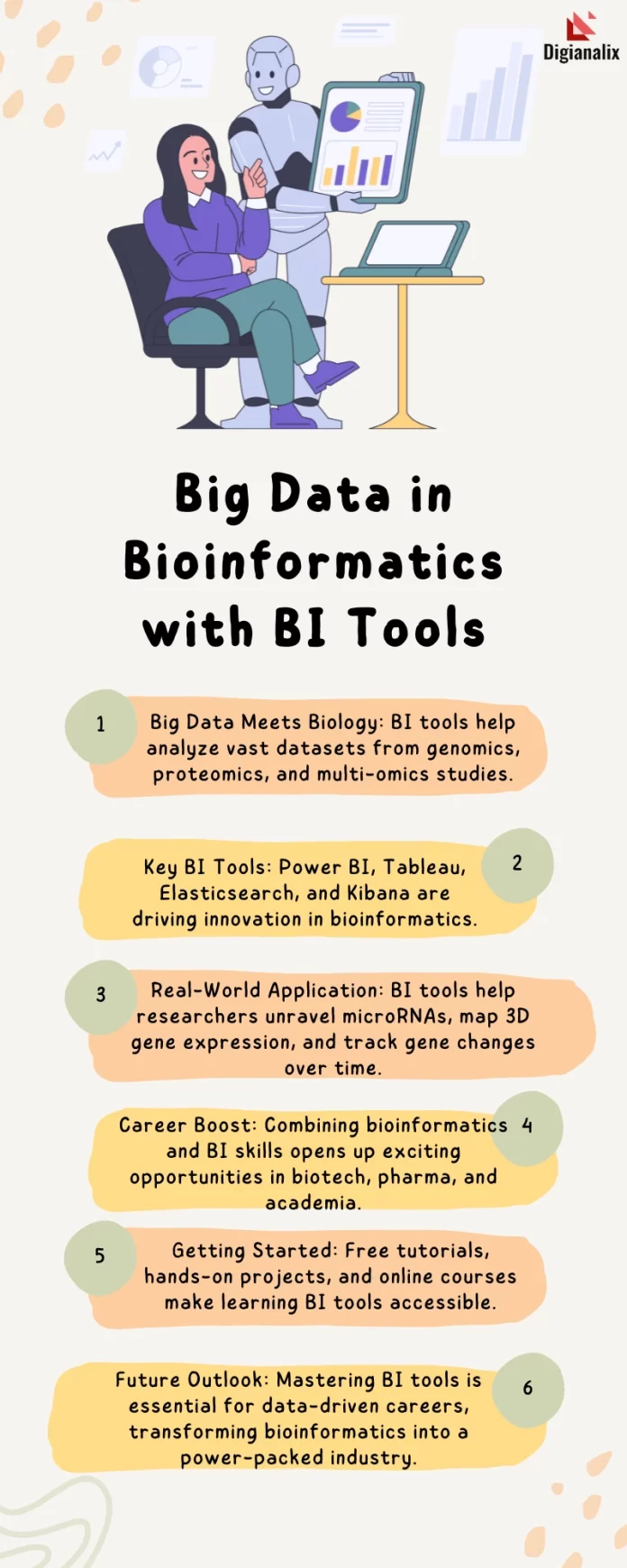Hey there, future data wizards and biotech innovators! 👋 Are you ready to dive into the exciting world where biology meets big data? Buckle up, because we’re about to explore how Business Intelligence (BI) tools are revolutionizing bioinformatics and opening up amazing career opportunities!
🧬 The Big Data Boom in Biology
Let’s face it – biology is drowning in data. From high-throughput sequencing to multi-omics studies, we’re generating more biological information than ever before. But here’s the million-dollar question: How do we make sense of it all? Enter Business Intelligence tools!
💼 Why BI Tools are Game-Changers for Bioinformatics
- Bridge the Gap: BI tools allow life scientists to wrangle massive datasets without needing a PhD in computer science.
- User-Friendly: Say goodbye to complex coding – these tools are designed with intuitive interfaces.
- Scalability: Handle datasets of any size, from a few genes to entire genomes.
- Versatility: Integrate data from multiple sources for a holistic view of biological systems.
🛠️ BI Toolbox for Bioinformatics
- Elasticsearch: Powerful search and analytics engine, perfect for indexing and querying large datasets.
- Power BI: Microsoft’s data visualization powerhouse, ideal for creating intuitive reports.
- Tableau: Create interactive, shareable dashboards.
- Kibana: Elasticsearch’s sidekick for data visualization, offering flexibility in visualizing complex biological relationships.
🔬 BI Tools in Action: Real-World Bioinformatics
- Unraveling microRNAs in Aging Researchers used BI tools to combine datasets like miRTarBase and miRBase to identify microRNAs involved in skin aging. By integrating these sources, scientists pinpointed potential gene regulatory mechanisms. Talk about fighting wrinkles with data!
- Multi-Omics Time Travel Tracking gene expression changes over time in diseases becomes a breeze with BI tools managing complex time-series data. For example, in longitudinal multi-omics studies of diabetes, researchers used BI platforms to analyze seasonal patterns of gut taxa, metabolites, and gene expression over years of follow-up.
- Mapping Gene Expression in 3D Tools like Kibana and Superset are revolutionizing spatial transcriptomics, allowing us to visualize gene expression patterns across tissue samples. This provides a clearer understanding of cellular heterogeneity during tissue repair processes, such as fibroblast migration post-injury.
🚀 Why You Should Jump on the BI Bandwagon
- Hot Job Market: Bioinformatics + BI skills = Career goldmine in academia, biotech, and pharma.
- Low Learning Curve: No need to be a coding guru to get started – most BI tools are intuitive.
- Stand Out from the Crowd: Impress potential employers with your data visualization superpowers.
- Versatility: These skills are valuable across various domains, from basic research to drug discovery and clinical applications.
💡 Getting Started with BI Tools
- Start with the Basics: Try free tutorials for Power BI or Tableau
- Hands-On Projects: Apply BI tools to publicly available genomics datasets (e.g., from TCGA or ENCODE)
- Online Courses: Platforms like Coursera and edX offer specialized bioinformatics and BI courses
- Join the Community: Engage in forums and webinars to learn from experts and stay updated on the latest tools
⚠️ Challenges to Keep in Mind
- Complex Biological Data Formats: Some formats like BAM, VCF, or high-resolution proteomics data may require intermediate processing.
- Massive Datasets: Handling enormous datasets might require cloud computing or distributed databases.
- Complementary Skills: Pair BI skills with some basic R or Python knowledge for advanced analyses like statistical modeling or machine learning.
🔮 The Future is Data-Driven
As a budding bioinformatician, mastering BI tools will set you up for an exciting career at the forefront of biological discovery. Start small—grab a free Power BI tutorial or explore publicly available genomics datasets like TCGA. With each project, you’ll build skills that bridge complex data with groundbreaking insights, driving innovations in healthcare, genetics, and drug development.
So, are you ready to become a BI-powered bioinformatics superhero? Share your thoughts and experiences in the comments below! Let’s start a conversation about how we can use these powerful tools to unlock the secrets hidden in biological big data.




